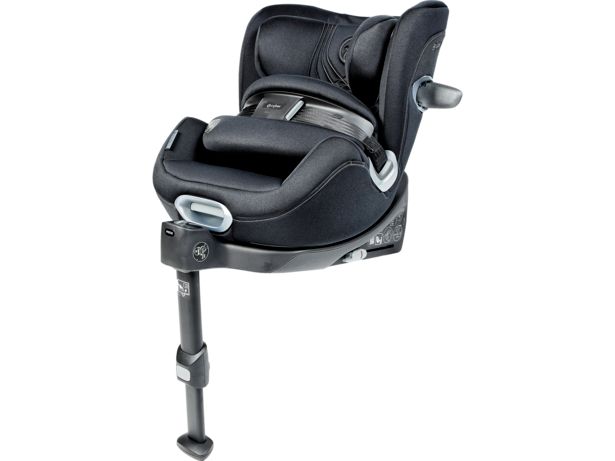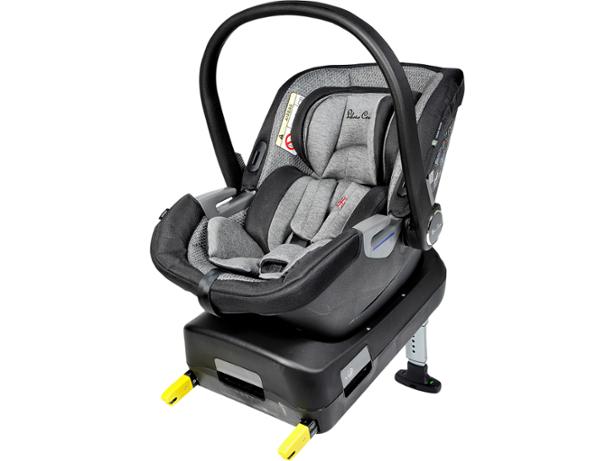What are isofix baby car seats?

Isofix is a child car seat attachment system that uses metal anchor points built in to the chassis of the car. The Isofix connectors from your baby or child car seat fit on to these. They’re designed to make installing a car seat much easier, which lowers the risk of getting it wrong.
The anchor points are often hidden within the car's seat padding. On some car seats, the Isofix connectors are part of the seat itself. With others, you have to buy a separate Isofix base to install into your car, and your seat will click on to this.
Once the connectors are clicked together with these anchorage points, a baby car seat has to be secured by a third point. This can either be a support leg, which comes built into the seat or seat base, or a top tether (a strap that attaches to a mount somewhere behind the rear seat).
Both of these work to prevent the car seat tipping forward in an accident and you can find out more about them below.
Jump to our isofix child car seat reviews to compare more than 100 car seats and find out which ones scored best in our testing
Do all cars have Isofix points?

The first car to have Isofix was the Volkswagen Golf IV in 1997. Since 2004 Isofix has become standard and now all new cars have Isofix on at least some of the back seats.
Top-tether anchor points for baby car seats have been common in cars since the end of 2012.
To find out if your car has Isofix anchor points, you should look between the back and base of the seats in your vehicle for metal rungs that you then click the car seat's Isofix connectors into. It may be labelled 'Isofix' or feature the symbol (shown in the image above).
Do all Isofix seats fit in Isofix cars?

No, not unless you have an i-Size seat and i-Size car. You need to check whether the car seat fits your car and any other cars it might be used in.
Most of the main manufacturers have a fit finder, which is a good starting point, but it's still important to try out the car seat in your car before you buy.
Visit our guide on how to fit a child car seat for tips and checklists to help you fit your car seat.
Keep your costs down and kids happy. Sign up for our Family newsletter, it's free monthly
How Isofix makes fitting car seats easier

Research into child car-seat fitting shows that car seats are routinely fitted incorrectly.
It's still possible to make mistakes with Isofix seats but they are, in general, easier to install than belted seats. This is because you simply plug the Isofix connectors into the anchor points found on the back seats of your car.
If you have Isofix anchor points in your car, we'd recommend using an Isofix child car seat.
Some car seats with Isofix connectors can still be used with just the adult car seat belt (if you wanted to use the same seat in a car that doesn’t have Isofix connectors, for example).
What is an Isofix support leg?

Many baby car seats are used with an Isofix base (either included with the car seat or bought separately), which is permanently installed into your car. You just click the baby car seat on and off.
The base will use a support leg that extends from the seat’s base to the car’s floor and locks into position. It’s designed to prevent your baby car seat from tipping forward in a crash.
Most car seats or seat bases with a support leg have something visual, such as a green or red indicator or an audible guide that will bleep at you if the leg is set to the wrong length or installed correctly.
If there are underfloor storage compartments in your car, you may not be able to use a seat with a support leg. This is because the lid of an underfloor storage compartment will not be strong enough to support a car seat in a crash.
Some cars may allow the use of a support leg resting on an underfloor compartment. It is vital you ask your car manufacturer what it recommends and check each car seat on a fit finder to check for your make and model of car.
Our child car seat reviews explain which installation methods you can use with each child car seat we test
What is top tether?

A top tether is a fabric strap that’s used to help secure a baby car seat (or extended rear-facing car seat) to a tether anchor point in the car.
The tether point is usually found in the boot somewhere, but not always, so refer to your car’s manual to find out where it is in your car.
If the design of your car prevents you using a car seat with a support leg (if there are underfloor compartments in the back, for example) you can use a top tether strap instead.
The tether stops the car seat pivoting forwards in a crash and helps absorb some of the crash forces.
When securing the top tether, it’s vital to make sure you’re attaching the strap to the correct anchor point in your car, as sometimes a tether point can be mistaken for a headrest stem or luggage tether fixing (neither of these are meant for use with a child car seat and aren't designed to withstand the forces of a crash).
All cars manufactured since November 2012 have to have top tether anchor points, but some much older cars will have them, too.
What is Isofit?
You’ll usually find Isofit connectors on Group 2/3 child car seats.
They do a similar job to the Isofix connectors you may be more used to on baby and toddler car seats, in that they connect to the Isofix anchor points on the back seat of your car, but they look a bit different.
Isofit connectors are more like large hooks on the end of flexible arms or sometimes straps (rather than the rigid arms of Isofix connectors).
The Isofit connectors hold the seat in place, while the car’s adult seat belt secures your passenger into the child car seat.
To see which child car seats thoroughly impressed out experts in our tough crash tests, check out the best baby or child car seats
How Isofix on Group 2/3 seats works differently
Isofix or Isofit connectors on a Group 2/3 or i-Size high-backed booster seats don’t work in the same way as they do for baby or toddler car seats.
They’re not designed to absorb the forces of a car crash, but are used to keep the seat in place when it’s not in use, as an unsecured child car seat becomes a very heavy projectile in an accident.
It’s the adult seat belt in a high-backed booster seat that helps distribute the force of a crash away from a child’s body.
Take a look at which ones we recommend in our guide to car seats for older children: high-back vs backless booster seats.



